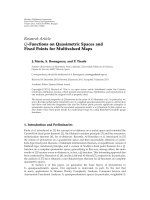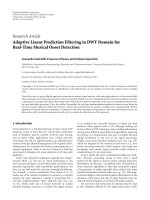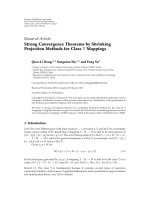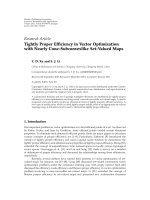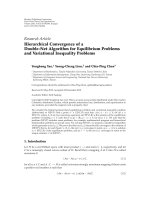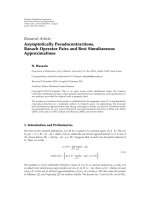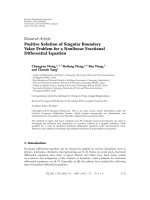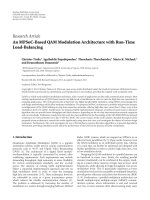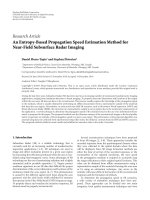Báo cáo hóa học: " Research Article Jointly Decoded Raptor Codes: Analysis and Design for the BIAWGN Channel" pdf
Bạn đang xem bản rút gọn của tài liệu. Xem và tải ngay bản đầy đủ của tài liệu tại đây (907.48 KB, 11 trang )
Hindawi Publishing Corporation
EURASIP Journal on Wireless Communications and Networking
Volume 2009, Article ID 657970, 11 pages
doi:10.1155/2009/657970
Research Article
Jointly Decoded Raptor Codes:
Analysis and Design for the BIAWGN Channel
Auguste Venkiah, Charly Poulliat, and David Declercq
ETIS, CNRS, ENSEA, Cergy-Pontoise University, 95014 Cergy-Pontoise Cedex, France
Correspondence should be addressed to Auguste Venkiah,
Received 6 August 2008; Revised 11 April 2009; Accepted 6 June 2009
Recommended by Tho Le-Ngoc
We are interested in the analysis and optimization of Raptor codes under a joint decoding framework, that is, when the precode
and the fountain code exchange soft information iteratively. We develop an analytical asymptotic convergence analysis of the joint
decoder, derive an optimization method for the design of efficient output degree distributions, and show that the new optimized
distributions outperform the existing ones, both at long and moderate lengths. We also show that jointly decoded Raptor codes are
robust to channel variation: they perform reasonably well over a wide range of channel capacities. This robustness property was
already known for the erasure channel but not for the Gaussian channel. Finally, we discuss some finite length code design issues.
Contrary to what is commonly believed, we show by simulations that using a relatively low rate for the precode (R p 0.9), we can
improve greatly the error floor performance of the Raptor code.
Copyright © 2009 Auguste Venkiah et al. This is an open access article distributed under the Creative Commons Attribution
License, which permits unrestricted use, distribution, and reproduction in any medium, provided the original work is properly
cited.
1. Introduction
Fountain codes were originally introduced [1] to transmit efficiently over a binary erasure channel (BEC) with
unknown erasure probability. They are of special interest
for multicast or peer-to-peer applications, that is, when no
feedback channel is available. Introduced by Luby [2], LT
codes are the first class of efficient fountain codes: by a
proper design of its so-called output distribution, an LT
code produces a potentially limitless number of distinct
output symbols from a set of K input symbols. The receiver
can then recover the input bits from any set of (1 + )K
output bits, where is the reception overhead. However,
high performance is achieved at a decoding cost growing in
O(K log(K)), which is too high to ensure linear encoding and
decoding time. To overcome this complexity issue, Raptor
codes have been firstly introduced by Shokrollahi in [3] for
the BEC channel: it simply consists in the concatenation
of an LT code with an outer code, called precode, which is
usually a high rate error correcting code. In [4], the author
independently presented the idea of precoding to obtain
linear decoding time codes. More recently, Raptor codes
have been studied on general binary memoryless symmetric
channels with information theoretic arguments [5]. In
particular, the authors proposed an optimization procedure
for designing good output degree distributions in the case
of transmission on the binary input additive white Gaussian
noise (BIAWGN) channel. In their optimization procedure,
the LT code and the precode are decoded separately, in
a tandem fashion, following the same framework as for
the BEC channel. The tandem decoder can however be
suboptimal, since it is possible to exchange soft information
between the precode and the fountain in an iterative way.
In this paper, we assume the joint decoding of the two
code components, and show that with proper design methods, we obtain Raptor codes with better performance and
robustness properties than the ones proposed in literature.
In a joint decoding framework, we use the extrinsic
information transfer function (EXIT function) of the precode as an additional knowledge in the system, and consider
this EXIT function in the asymptotic density evolution
equations of the Raptor code under Gaussian approximation.
By optimizing the distribution with this new set of equations,
the fountain is matched to a particular precode behavior,
which leads to a substantial performance improvement. Note
that our approach has the great advantage that both the
2
EURASIP Journal on Wireless Communications and Networking
analysis and the design remain fully analytical and linear
in the parameters, that is fountain distributions are easy to
optimize.
Aside from the better results, we also show that optimizing Raptor codes under the joint decoding framework
has also other advantages on the properties of the coded
system. The first advantage relates to the robustness of the
transmission to channel variations. On the BEC channel,
Raptor codes are universal, as they can approach the capacity
of the channel arbitrarily closely, and independently of the
channel parameter [3]. This is a very special case, since
the results in [5] show that Raptor codes are not universal
on other channels than the BEC. Nevertheless, one can
characterize the robustness of a Raptor code by considering
the variation of the overhead over a wide range of channel
capacities. In particular, we will show with a threshold
analysis that the Raptor codes optimized under the joint
decoding framework and with a smart choice of optimization
parameters are more robust than the distributions proposed
in [5]. An alternative solution has been proposed in [6],
where the authors propose the construction of generalized
Raptor codes, by allowing the output degree distribution to
vary as the output symbols are generated. This construction
has the advantage that the resulting codes can approach the
capacity of a noisy symmetric channel in a rate compatible
way. However, no code design technique has been proposed
for generalized Raptor codes, mainly due to the fact that their
structure is not as easy to optimize compared to usual Raptor
codes.
Finally, we address the issues raised by the finite length
construction of Raptor codes. For practical applications, it
is important that codes which perform well asymptotically
also give good performance at finite length. The design of
Raptor codes at finite length has already been addressed for
the BEC [7, 8] and the BSC [9]. Unlike LDPC codes that
can be conditioned to perform well at finite length by a
careful design of the graph [10, 11], the underlying graph
of a Raptor code is random by nature, and no such technique
can be used. Our framework partially addresses this problem,
by naturally addressing the rate repartition between the
fountain code and the precode. Since the fountain is matched
to the precode in our framework, the use of precodes with
rates far lower than the one proposed in literature is possible
without sacrificing much on the overall performance. Using
this additional degree of freedom, we obtain finite length
Raptor codes with considerably lower error floors, with a
negligible loss in the waterfall region. This can also be seen as
robustness of our constructions to varying information block
lengths.
The remainder of this paper is organized as follows. In
Section 2, we describe the system that we consider and give
the notations used in the paper. In Section 3, we study the
asymptotic performance of jointly decoded Raptor codes on
the BIAWGN channel and derive an optimization method
for the design of efficient output degree distributions. Then,
we show with threshold computations that under the joint
decoding framework, Raptor codes are robust to a channel
variation. In Section 4, we consider the problem of finite
length design by properly addressing the rate splitting issue,
and finally, conclusions and perspectives are drawn in
Section 5.
2. System Description and Notations
2.1. Definitions and Notations. We consider in this paper only
coded transmissions over the BI-AWGN channel. We call
input symbols the set of binary information symbols to be
transmitted and output symbols the symbols produced by an
LT code from the input symbols. At the receiver side, belief
propagation (BP) decoding is used to recover iteratively the
input symbols from the noisy observations of the output
symbols.
An LT code is described by its output degree distribution Ω [2]: to generate an output symbol, a degree d is
sampled from that distribution, independently from the past
samples, and the output symbol is then formed as the sum
of a uniformly randomly chosen subset of size d of the input
symbols. Let Ω1 , Ω2 , . . . , Ωdc be the distribution weights on
degrees 1, 2, . . . , dc , so that Ωd denotes the probability of
choosing the value d. Using polynomial notations, the output
degree distribution can be written compactely as Ω(x) =
dc
dc
j
j −1 = Ω (x)/Ω (1) is the correj =1 Ω j x . ω(x) =
j =1 ω j x
sponding edge degree distribution in the Tanner graph (see
Figure 1). In these notations, dc represents the maximum
degree of the parity-check equations used in the generation
of output symbols. Because the input symbols are chosen
uniformly at random, their node degree distribution is
binomial, and can be approximated by a Poisson distribution
with parameter α [3, 5]. Thus, the input symbol node degree
distribution is defined as: I(x) = eα(x−1) . Then, the associated
input symbol edge degree distribution ι(x) = I (x)/I (1)
is also equal to eα(x−1) . Both distributions are of mean α.
Technically, ι(x) and I(x) cannot define degree distributions
since they are power series and not polynomials. However,
the power series can be truncated to obtain polynomials that
v
are arbitrarily close to the exponential [5]: I(x) = d=1 Ii xi
i
dv
i−1 . The maximum degree
and ι(x) = I (x)/I (1) = i=1 ιi x
dv is chosen sufficiently high.Although fountain codes are
rateless, we can still define an a posteriori rate RLT for a
fountain code as follows:
RLT =
=
Nb input symbols
Nb output symbols needed for successful decoding
Ω (1)
.
α
(1)
For a Raptor code, the a posteriori rate is R = R p · RLT , where
R p denotes the rate of the precode. Recall that, as a main
measure of performance, Raptor codes are usually illustrated
in terms of error rates versus the value of the overhead
. is defined as C = R(1 + ) where C is the channel
capacity. Finally, the Tanner graph of a Raptor code is given
in Figure 1. Note that we did not represent the Tanner graph
of the precode: in general, the precode can be any block code,
and not necessarily a LDPC code like we considered in this
paper.
EURASIP Journal on Wireless Communications and Networking
Precode
Input symbols
LT code
Interleaver
Output symbols
Figure 1: Description of a Raptor code. Tanner graph of an LT code
+ precode. The black squares represent parity-check nodes and the
circles are variable nodes associated with input symbols or output
symbols.
2.2. Tandem and Joint Decoding of a Raptor Code. Since a
Raptor code is a serial concatenation of two component
codes, two decoding schemes can be considered
(a) In a classical setting, the tandem decoding (TD)
is used: it consists in decoding the LT code first
and then the precode independently, using the soft
extrinsic information on the input symbols as a priori
information for the precode.
(b) In a joint decoding (JD) framework, both decoder
components of the Raptor decoder provide extrinsic
information to each other in an iterative way.
Most of the analysis and designs of Raptor codes in
literature assume a tandem decoding. In this paper, we
show that using an iterative joint decoder allows to obtain
better coding solutions to some issues, such as robustness
to channel variation and to finite length design. In the next
section, we draw the density evolution analysis under Gaussian approximation, and show the advantages of considering
a joint decoder.
3
Under JD framework, we assume that extrinsic information
is exchanged between the precode and the fountain part
from one decoding iteration of the fountain to the other.
Moreover, we mainly consider the case of an LDPC precode.
In this case, the Raptor code can be described by a single
Tanner graph with two kinds of parity-check nodes: check
nodes of the precode, referred to as static check nodes and
parity-check nodes of the LT code, referred to as dynamic
check nodes in the following [5]. Throughout the decoding
iterations, we analytically track the evolution of the IC
associated with the LDR messages that are located at the
fountain side of the Tanner graph.
(l)
3.1.1. Information Content Evolution. We denote by xu
(l)
(resp., xv ) the IC associated to messages on an edge
connecting a dynamic check node to an input symbol
(resp., an input symbol to a dynamic check node) at
(l−
the lth decoding iteration. Moreover, we denote by xext 1)
the extrinsic information passed from the LT code to the
precode, at the lth decoding iteration, and T(·) : x →
T(x) the IC transfer function of the precode. The extrinsic
information passed by the precode to the LT code is then
(l)
T(xext ). The notations are summarized in Figure 2.
When accounting for the transfer function of the precode, the IC update rules in the Tanner graph can be written
as follows (see other references for the detailed explanation
of such system of equations [5, 12, 15])
(i) Input symbol message update:
dv
(l)
xv =
(l−
(l
ιi J (i − 1)J −1 xu −1) + J −1 T xext 1)
.
(3)
i=1
(ii) Dynamic check node message update is
3. Asymptotic Analysis and Design of
Raptor Codes for Joint Decoding
dc
(l)
xu = 1 −
R
log2 (1 + e−ν ) exp −
(ν − m)
4m
(4)
j =1
3.1. Asymptotic Analysis of Raptor Codes. In this section,
we derive the asymptotic analysis of the joint decoding
of Raptor codes on the BIAWGN channel. The analysis
is presented from the fountain point of view for our
optimization purposes. To perform this asymptotic analysis,
we adopt a monodimensional analysis of the BP decoder
based on EXIT charts [12, 13]. It is based on a Gaussian
approximation (GA) [14] of the density evolution (DEs) as
presented in [15, 16]. In the iterative decoder, the messages
are defined as log density ratios (LDRs) of the probability
weights. Under GA assumption, the LDRs are considered
as realizations of a Gaussian random variable with mean
m and variance σ 2 = 2m [14]. We call information content
(IC), the mutual information between a random variable
representing a transmitted bit and another one representing
an LDR message on the decoding graph. The IC associated to
an LDR message is x = J(m) [12], where J(·) is defined by
1
J(m) = 1 − √
4πm
(l)
j − 1 J −1 1 − xv + f0
ωjJ
2
dν,
(2)
with f0 J −1 (1 − J(2/σ 2 )).
(iii) Precode extrinsic information update is
(l)
xext =
(l)
Ii J iJ −1 xu
.
(5)
i
Replacing (3) in (4) gives (7), the monodimensionnal
(l)
(l
recursive equation: xu = F(xu −1) , σ 2 , T(·)) that describes
the evolution through one joint decoding iteration of the
IC of the LDRs at the output of the dynamic check nodes
(fountain part):
(l)
(l
xu = F xu −1) , σ 2 , T(·)
dv
=1−
j =1
⎛
(6)
⎛
dc
ω j J ⎝ j − 1 J −1 ⎝1 −
(l
ιi J (i − 1)J −1 xu −1)
i=1
⎞
+ J −1 T
(l−
xext 1)
⎞
⎠ + f0 ⎠
(7)
4
EURASIP Journal on Wireless Communications and Networking
(l−1)
equations under Gaussian approximation converge to a
stable fixed point. The same study with similar results has
been conducted in [5], but for a different set of equations
since the authors used the evolution of the mean of the
Gaussian density, instead of the information content.
(l−1)
xext
T (xext )
Input symbol
(l)
3.1.3. Fixed Point Characterization. In an IC evolution
analysis, the convergence is guaranteed by the condition
F(x, σ 2 , T(·)) > x. Unfortunately, there are no trivial
(l
solutions for the fixed point of (7). Replacing xu −1) by 1 (its
maximal value) and using the fact that T(1) = 1 in (7), we
can however obtain the following upper bound:
(l)
xu
xv
Dynamic check node
lim F x, σ 2 , T(·) = J
Output symbol
x→1
Figure 2: Notations used for the asymptotic analysis of a Raptor
code with IC evolution.
Note that for a given distribution ι(x), this expression is
linear with respect to the coefficients of ω(x), which is the
distribution that we intend to optimize. Let us also point out
that (7) is general since it reduces to the classical tandem
decoding case by setting the extrinsic transfer function to
x → T(x) = 0 for all x ∈ [0; 1], thus assuming that
no information is exchanged between the precode and the
fountain.
3.1.2. On the Precode IC Transfer Function. If the precode is
an error correcting code that has a soft-input soft-output
decoding algorithm, then its transfer function x → T(x)
can be estimated with Monte Carlo simulations. When the
precode is an LDPC code, an analytical expression of the
transfer function can be given. Let λ(x) (resp., Λ(x)) denote
the variable edge (resp., node) degree distribution and ρ(x)
the check edge degree distribution, then the IC transfer
function [17] is given by:
dv
T(x) =
i=2
⎛
⎛
Λi J ⎝iJ −1 ⎝1 −
2
σ2
x0 .
(9)
Thus, the IC of the LT part of a Raptor code is upper bounded
through the decoding iterations by x0 , which is equal to the
capacity of a BIAWGN channel with noise variance σ 2 .
3.1.4. Starting Condition. If the following condition is not
met, then the decoding of a Raptor code to a zero error fixed
point is not possible.
Proposition 1 (Starting condition). The decoding process can
begin if and only if F(0, σ 2 , T(·)) > 0 and the following holds:
F 0, σ 2 , T(·) > ε ⇐⇒ ω1 >
ε
.
J(2/σ 2 )
(10)
(1)
Proof. The decoding process can begin if and only if xu > ε,
(0)
for some arbitrarily small ε > 0. At the first iteration, xu = 0,
(1)
and (7) gives xu = F(0, σ 2 , T(·)) = ω1 J(2/σ 2 ).
Roughly speaking, one must have ω1 > 0 for the decoding
process to begin. Thus, the parameter ε appears to be a design
parameter to ensure that ω1 = 0. In practice, the value of ε can
/
be chosen arbitrarily small.
⎞⎞
dc
ρjJ
j − 1 J −1 (1 − x) ⎠⎠.
j =2
(8)
Note that even if we used—for simplification—the same
notation dv for the maximum connexion degree for the
precode (8) and the fountain (7), these two degrees could
take different values. Using (8) as stated implicitly implies
that: (a) one inner iteration is performed and (b) the
messages in the precode Tanner graph are reinitialized
each time the fountain passes its soft information to the
precode. This pessimistic assumption is crucial to lead to a
linear optimization problem with respect to the optimization
parameter. However, it has been found sufficient for the
design of good output degree distributions. Note that, in
practice, we will keep during the decoding the computed
values of the extrinsic messages everywhere in the Tanner
graph, without any re-initialization.
In the rest of the section, we derive the conditions on the
distribution first monomials such that the density evolution
3.1.5. Lower Bound on ω2 (Flatness Condition). In [5], an
important bound on Ω2 , the proportion of output symbols
of degree 2, has been derived for sequences of capacity
achieving distributions, which is a counterpart of the stability
condition [16] for LDPC codes. Following steps of [5], we
derive a similar bound for the proportion ω2 of a capacity
achieving distribution ω(x), specifically for the IC evolution
system of equations.
Proposition 2. When considering IC evolution, the necessary
condition for a distribution ω(x) to be capacity achieving is:
F 0, σ 2 , T(·) > 1 ⇐⇒ ω2 >
1
.
αe− f0 /4
(11)
Proof. see the appendix
This lower bound on the output nodes of degree 2 for
a capacity achieving output degree distribution ensures that
x = 0 is not an attractive fixed point of the decoder (i.e.,
the decoder successfully starts). We point out that the IC
EURASIP Journal on Wireless Communications and Networking
evolution method leads to a slightly different result than the
one obtained with mean evolution [5]. However, the same
phenomenon has been observed for the derivation of the
stability condition of LDPC codes.
3.2. Design of Output Degree Distributions. In this section,
we explicit the optimization problem for the design of good
output degree distributions, and give some complementary
results that we use for the choice of the design parameters.
We assume that the channel parameter σ 2 is known, that is
to say that the output degree distribution is optimized for a
given channel parameter.
3.2.1. Optimization Problem Statement. For a given value
α, the optimization of an output distribution consists in
maximizing the rate of the corresponding LT code: this
is achieved when maximizing Ω (1) =
i Ωi i, which is
equivalent to minimizing i ωi /i. Thus, the optimization
problem can be stated as follows:
ωopt (x) = arg min
ω(x)
j
ωj
j
(12)
subject to the following constraints [Ci ] (according to the
previous section).
[C1] Proportion constraint. i ωi = 1. Since ω(x) is a
probability distribution, its coefficients must sum up
to 1.
[C2] Convergence constraint. F(x, σ 2 , T(·)) > x for all x ∈
[0; x0 − δ] for some δ > 0. To ensure the convergence
of the iterative process, we must have F(x, σ 2 , T(·)) >
x. However, this inequality cannot hold for each and
every value of x: the analysis in Section 3.1.3 shows
that the fixed point of F(x, σ 2 , T(·)) is smaller than
x0 = J(2/σ 2 ). Therefore, we must fix a margin δ > 0
away from x0 , and then by discretizing [0; x0 − δ]
and requiring inequality to hold on the discretization
points, we obtain a set of inequalities that need to
be satisfied. The influence of the parameter δ is
discussed in Section 3.2.3.
[C3] Starting condition. ω1 > ε/J(2/σ 2 ) for some ε > 0.
[C4] Flatness condition. ω2 > 1/αe− f0 /4 .
For a given value of α, and a given channel parameter σ 2 ,
the cost function and the constraints are linear with respect
to the unknown coefficients ωi . Therefore, the optimization
of an output degree distribution can be written as a linear
optimization problem that can be efficiently solved with
linear programming.
3.2.2. Parameter α. The average degree of input symbols α is
the main design parameter of the optimization problem. For
increasing values of the design parameter α, we optimized
output degree distributions as explained in the previous
section. As illustrated on Figure 3, there is a value for α
that maximizes the corresponding rate of the LT code. In
this example, the distributions are optimized for a BIAWGN
5
channel of capacity C = 0.5, with a regular (3,60) precode of
rate R p = 0.95. Remarking that we have as performance limit
−1
RLT R p < C, we get a lower bound on RLT . In our case, this is
given by
Rp
0.95
=
= 1.9.
(13)
C
0.5
Remark 1. The preceding example leads to the following
general remark. As RLT R p < C, we get an upper bound on the
maximum achievable rate of the fountain: RLT < C/R p . Note
that it is always greater than C. So, an effective optimization
of the fountain should give a rate as close as possible to
this limit, as observed in our example. Note that effectively,
the “best” fountain obtained through optimization has an
effective rate RLT > C.
−1
RLT >
We now show that there is a minimum value αmin under
which it is not possible to design zero error output degree
distributions. Let us first assume that the fountain part of the
(
Tanner graph has converged to its fixed point xu∞) < x0 < 1.
The extrinsic information content transmitted to the precode
is upper bounded by
(
xext ≤ J αJ −1 xu∞)
.
(14)
With the re-initialization assumption of the precode Tanner
graph (see Section 3.1), we can assume that the precode is
an LDPC code with asymptotic decoding threshold x p . This
means that if the precode is initialized with an information
content—coming from the fountain—greater than x p , then
the information content of the precode alone will converge
to 1, and the Raptor code has a threshold behavior. It follows
that the minimum value of α is given by the condition xext >
xp , which gives
α≥
σ 2 J −1 xp
(15)
αmin .
2
Note that although this condition looks like what we implied
(
a tandem decoder, the value of xu∞) is effectively obtained
with the joint decoder equations (7).
3.2.3. Parameter δ. Following the same trend as in the
(
previous section, and recalling that xu∞) = x0 − δ for a
converging output distribution, we can also discuss how to
fix the value of δ in the optimization procedure. Again, one
must have xext > xp , and for some value α ≥ αmin , it follows
that
⎛
δ ≤ x0 − J ⎝
σ 2 J −1 xp
2
⎞
⎠.
(16)
We recall that δ represents a margin away from x0 : the choice
δ = 0 leads to an overly stringent optimization problem.
Moreover, the larger δ, the higher the asymptotic rate,
because the optimization problem becomes less constrained
when δ becomes larger. However, inequality (16) shows that
δ cannot be chosen arbitrarily. In practice, a good choice for
δ is therefore a value as close as possible to the right hand of
(16).
6
EURASIP Journal on Wireless Communications and Networking
2.1
100
2.05
10−1
BER
−1
RLT
10−2
2
10−3
1.95
10−4
1.9
10−5
9
10
11
12
α
13
14
15
−1
Figure 3: Asymptotic rate of an LT code: RLT versus α. For
increasing values of α, we optimize a distribution to match a (3,60)
regular LDPC precode of rate R p = 0.95 on a BIAWGN channel
of capacity C = 0.5 (σ = 0.9786),. and compute the a posteriori
rate RLT = Ω (1)/α. It appears that is an optimal value for α that
−1
minimizes RLT , that is, that minimizes the asymptotic overhead.
3.2.4. Simulation Results. The simulation results are illustrated in terms of BER versus overhead . We used a regular
(3,60) LDPC precode of length N = 65000, generated
randomly. We compare the distribution ΩE (x) proposed in
[5, page 2044], with both and decoders, to the following
distribution that we optimized for with our method:
ΩB (x) = 0.00428x + 0.49924x2 + 0.01242x3 + 0.34367x4
10
11
+ 0.04604x + 0.06181x + 0.02163x
22
+ 0.01091x23 .
(17)
Simulation results are reported on Figure 4.
For the state-of-the-art distribution ΩE (x) there is very
little difference between and decoders. This can be explained
by the fact that the distribution has not been optimized to
take into account the information provided by the precode.
Compared to the distribution ΩE (x), our distribution ΩB (x)
appears to operate closer to the channel capacity: the
overhead is more that 10% in the first case and less than 5%
for our distribution. This result shows that one can design
better output degree distributions by proper optimization
with a joint decoding framework.
3.3. Threshold of a Raptor Code. In this section, we discuss
the threshold behavior of Raptor codes under joint decoding
with the IC evolution model, and compute numerically the
thresholds for the two distributions ΩE (x) and ΩB (x).
3.3.1. Threshold Behavior of a Raptor Code.
Definition 1 (Threshold). The a posteriori rate is the rate
below which the decoding is successful. The threshold ∗ of
0
0.05
0.1
ΩE (TD)
ΩE (JD)
0.15
0.2
0.25
Overhead
0.3
0.35
0.4
ΩB (JD)
Figure 4: BER versus overhead for a Raptor code defined with
a regular (3,60) LDPC precode of size N = 65000. We compare
ΩB (x), a distribution that we optimized for joint decoding, to ΩE (x)
proposed in [5] under tandem decoding (squares) and under joint
decoding (stars). The thresholds of the corresponding distributions
are also reported on the figure (c.f. Section 3.3). Simulations are run
on a BIAWGN channel of capacity C = 0.5 (σ = 0.9786) with 600
decoding iterations.
a Raptor code is the asymptotic overhead corresponding to
expectation of its a posteriori rate.
We only consider the case such that the precode is a block
error correcting code with a threshold behavior (an LDPC
code e.g.,). For tandem decoding, it is clear that the Raptor
code has a threshold behavior: when LT code converges to its
fixed point, it is sufficient that this fixed point is such that the
extrinsic information passed to the precode is higher than the
precodes threshold.
In the case of joint decoding, we adopt the same
strategy, except that during the convergence of the extrinsic
information passed from the fountain to the precode to its
(
limiting value xu∞) , we assume belief propagation decoding
on the whole Raptor code Tanner graph. The scheduling
that we propose has then two steps: during the first step,
the Raptor code is decoded under joint decoding, and
the LT part of the Tanner graph converges to its fixed
point. The convergence is guaranteed by (7) under Gaussian
approximation. During the second step, the precode is
decoded alone, and the extrinsic information passed from
the LT code is used as a priori information for the precode.
Since the precode is assumed to have a threshold, the joint
decoding of a Raptor code with the proposed scheduling
exhibits a threshold behavior.
3.3.2. Robustness against Channel Parameter Mismatch. To
compute the threshold of a Raptor code, we use a numerical
method that is an instance of Density Evolution (DEs),
by Monte Carlo simulations. This method gives as good
EURASIP Journal on Wireless Communications and Networking
7
Table 1
K = 2048
K = 1024
Code rate (R)
0.9625
0.95
0.925
0.9
Code rate (R)
0.9625
0.95
0.925
0.9
Code rate (R)
0.9625
0.95
0.925
0.9
estimations for the decoding thresholds as the histogram
approach. We used the estimation of thresholds of DE to
show the robustness of the designed output distribution to
channel parameter mismatch.
The results in [5] show that Raptor codes are not
universal on other channels than the BEC: they cannot
adapt to themselves to an unknown channel noise and
approach the capacity of the channel arbitrarily closely.
However, it turns out that the distributions are quite robust
to channel variation, when a joint decoder is used. In order
to show this robustness, we have computed for different
channel capacities the thresholds of the distribution ΩE (x)
[5] and ΩB (x) (our distribution). The results are reported
on Figure 5 and it can be seen that both distributions have
almost constant thresholds for all considered capacities,
which shows that even though not universal, Raptor codes
on the BIAWGN channel with joint decoding are very robust.
Moreover, one can see that our optimization procedure
produces an output degree distribution with thresholds
outperforming the one of [5] for all capacities. For example,
at C = 0.4, the threshold is only 2% away from the capacity
of the channel.
Number 4-cycles
643
0
0
0
Number 4-cycles
3536
860
0
0
Number 4-cycles
5356
2328
90
0
Number 6-cycles
683392
259567
47157
9728
Number 6-cycles
693044
289392
70493
19982
Number 6-cycles
716492
295760
83869
31394
Threshold ε versus channel capacity C
0.16
0.14
0.12
0.1
ε∗
K = 4096
(dv ,dc )
(3,80)
(3,60)
(3,40)
(3,30)
(dv ,dc )
(3,80)
(3,60)
(3,40)
(3,30)
(dv ,dc )
(3,80)
(3,60)
(3,40)
(3,30)
0.08
0.06
0.04
0.02
0
0.2 0.25
0.3 0.35
0.4 0.45
0.5 0.55
0.6 0.65
0.7
C
ΩE
ΩB
Figure 5: Thresholds of two distributions optimized for C = 0.5,
for different channel capacities. We compare ΩB (x), a distribution
that we optimized for joint decoding, to ΩE (x) proposed in [5]
decoded under joint decoding.
4. Finite Length Design
In this section, we discuss some important issues concerning
the choice of the precode, in the perspective of designing
efficient Raptor codes for small to moderate lengths. Indeed,
the limitations in designing good high-rate precode for
considered code lengths (i.e., with good girth properties)
imposes the consideration of lower rate precodes. Using our
asymptotic optimization method, we show that the choice
of a rate lower than usually proposed for precodes enables
to design good Raptor codes. We obtain raptor codes which
perform well at small lengths, with almost no asymptotic
loss. We show in particular that the error floor can be greatly
reduced by properly choosing the rate splitting between the
precode and the LT code.
4.1. The Rate Splitting Issue. In literature, the rate of the
precode is usually chosen very close to 1, for the following
reason. The optimization of output degree distributions
allows to design LT codes such that the fraction of unrecovered input symbols is extremely low. Choosing a very high
rate precode is a valid strategy when the two components
of the Raptor code are decoded sequentially, and when the
information block length is sufficiently high so that the
asymptotic analysis holds.
The choice of a high-rate precode could nevertheless be a
suboptimal choice when we consider iterative joint decoding
of the precode and the LT code and/or the block length is
small. Indeed, for short to moderate lengths, the topology
8
EURASIP Journal on Wireless Communications and Networking
1
(3, XX) LDPC precoded Raptor codes
over the BIAWGNC (K = 2048)
10−1
0.95
Frame error rate
R (code rate)
100
0.9
0.85
102
103
104
N (codeword length)
Rate UB (g = 6)
K = 1024
K = 2048
105
10−3
10−4
10−5
10−6
K = 4096
K = 8192
Figure 6: Upper bound on the code rate (Rate UB) such that a
regular (3, dc ) LDPC code of girth 6 (no 4-cycles) and size N exists.
0
0.05
0.1 0.15
0.2 0.25 0.3 0.35
Overhead (%)
(3, 30) − R p = 0.9
(3, 40) − R p = 0.925
0.4
0.45
0.5
(3, 60) − R p = 0.95
(3, 80) − R p = 0.9625
Figure 8: Performance of LDPC precoded Raptor codes of size
K = 2048. The lowest rates R = 0.9 and R p = 0.925 show good
performance, whereas the Raptor codes with precodes of higher
rates exhibit a severe error floor.
(3, XX) LDPC precoded Raptor codes
over the BIAWGNC (K = 1024)
100
10−2
Frame error rate
10−1
10−2
10−3
10−4
10−5
10−6
0
0.05
0.1 0.15
0.2 0.25 0.3 0.35
Overhead (%)
(3, 30) − R p = 0.9
(3, 40) − R p = 0.925
0.4
0.45
0.5
(3, 60) − R p = 0.95
(3, 80) − R p = 0.9625
Figure 7: Performance of LDPC precoded Raptor codes of size
K = 1024. Only the lowest considered rate R p = 0.9 shows good
performance. For all other precode rates, the code exhibits an error
floor, which can be explained by the large number of small cycles in
the precode Tanner graphs.
of the overall Tanner graph in terms of short cycles and
subsequent stopping/trapping sets needs to be considered
for the optimization. Using graph theoretic argument, it
can be shown that, using a very high rate LDPC precode
can introduce a large number of length-4 cycles. More
precisely, the code length such that a LDPC codes of girth
6 (no length-4 cycles) exist grows exponentially with the
check node degree dc [10], hence grows with the code rate
(cf. e.g., the upper bound in Figure 6). Having unavoidable
short cycles results in error floors which are unacceptably
high, as demonstrated by our simulations. So, we need to
take this fact into consideration when performing the optimization, since asymptotic arguments only are not sufficient
anymore. Therefore, considering a lower rate precode has
the main objective of improving the Raptor code in the
error floor region for finite block lengths, by allowing LDPC
precodes with girth 6.
We show in this section that if the output degree
distribution is matched—with proper optimization—to the
EXIT chart of a lower rate precode, there is almost no
asymptotic loss, that is, no loss in the waterfall region, but
one can obtain Raptor codes which have better error floors at
finite lengths. By lower rate, we mean rates that are between
R p = 0.9 and R p = 0.95, whereas typically in the existing
literature, very high rate codes, for example, R p = 0.98,
are considered. Indeed, as pointed out in the remark in
Section 3.2.2 RLT is upper bounded by a rate greater than
C. When performing joint decoding, the optimized output
degree distributions tends effectively to have a rate RLT > C.
In fact, through the objective function of the optimization,
one intends to minimize the overhead: the code will have
a global rate R close to the capacity. It easily allows to
consider precodes with lower rates and to raise the issue of
the repartition of the overall rate between the LT code and
the precode.
4.2. On Cycle Spectrum of Finite Length LDPC Precoder.
For our purpose, we will consider Raptor codes of size
EURASIP Journal on Wireless Communications and Networking
(i) (dv , dc ) = (3, 30) regular LDPC code of rate R p = 0.9;
(ii) (dv , dc ) = (3, 40) regular LDPC code of rate R p =
0.925;
(iii) (dv , dc ) = (3, 60) regular LDPC code of rate R p =
0.95;
(iv) (dv , dc ) = (3, 80) regular LDPC code of rate R p =
0.9625.
(3, XX) LDPC precoded Raptor codes
over the BIAWGNC (K = 4096)
100
Frame error rate
10−1
10−2
10−3
10−4
10−5
10−6
0
0.05
0.1
0.15
0.2 0.25
0.3 0.35
0.4 0.45
0.5
Overhead (%)
(3, 30) − R p = 0.9
(3, 40) − R p = 0.925
(3, 60) − R p = 0.95
(3, 80) − R p = 0.9625
Figure 9: Performance of LDPC precoded Raptor codes of size K =
4096 The precode of highest rate R p = 0.9625 exhibit a severe error
floor behavior.
(3, XX) LDPC precoded Raptor codes
over the BIAWGNC (K = 8192)
100
Frame error rate
10−1
10−2
10−3
10−4
10−5
10−6
0
0.05
0.1
0.15
0.2 0.25
0.3 0.35
0.4 0.45
0.5
Overhead (%)
(3, 30) − R p = 0.9
(3, 40) − R p = 0.925
9
(3, 60) − R p = 0.95
(3, 80) − R p = 0.9625
Figure 10: Performance of LDPC precoded Raptor codes of size
K = 8192. With very little loss in the waterfall region, the precode
of rate R p = 0.9 does not exhibit an error floor.
K = 1024, 2048, 4096 and 8192. We restricted ourselves to
regular LDPC precodes because for high rates, regular codes
are known to have good thresholds, close to the irregular
thresholds. We considered regular LDPC precodes with the
following parameters:
The different LDPC precodes (one for each rate and
size) were constructed with a PEG-based algorithm that
minimizes the multiplicity of the girth [18]. We denote by
X-cycle a cycle of length X. All the precodes of size K = 8192
are of girth 6 (i.e., they have no 4-cycles in their associated
Tanner graph). The other (dv , dc ) LDPC precodes have the
following cycle spectrums in Table 1 .
We emphasize that the 4-cycles in the other codes do not
result from a poor construction, but from the fact that for the
corresponding rates and sizes, it is not possible to construct
regular (3, dc ) LDPC codes [10] of girth 6 (no 4-cycles). To
illustrate this fact, the upper bound on the code rate such
that a regular (3, dc ) LDPC code of girth 6 and size N exists
is reported in Figure 6. The coding rates and sizes of the
16 precodes that we used are also reported in the figure. It
appears that our constructions with 4-cycles all correspond
to a size and coding rate that do not permit the construction
of graphs with no 4-cycles [10]. Note that we have considered
so far rates no lower than R = 0.9. According to the upper
bound on the code rate, the minimum codeword length to
have a code of rate R = 0.9 with girth-6 is N = 600 which
is very short length for our purposes. As we will see later,
considering shorter lengths for having lower rate is not a
reasonable choice for practical reasons with regards to the
resulting overhead.
4.3. “Asymptotic Design” for Finite Length Distributions. If we
have to consider lower rate precodes to account for finite
length design constraints, one also might question whether
the asymptotic analysis of the joint decoder remains valid for
finite length design. Indeed, in the asymptotic regime, the
concentration theorem [16] ensures that the performance
of a randomly sampled code converges to the expected
performance as the codeword length increases. For EXIT
charts, the x → F(x, σ 2 , T(·)) characterizes the expected
IC evolution of the decoder in the asymptotic regime. In
the asymptotic regime, that is, when the codeword length
is infinite, the decoding trajectory in the EXIT chart will fit
between the curves y = x and y = F(x, σ 2 , T(·)). However,
the concentration to the expected performance does not hold
for the finite length case, and one must account for a certain
variance in the decoding trajectories. Following the steps of
[3], we propose to use the following convergence constraint
in the optimization problem for finite length
[C2 ] Convergence constraint is
c√
1−x
F x, σ 2 , T(·) > x +
K
∀x ∈ [0; x0 − δ]
for some δ > 0,
where c is a (small) positive constant.
(18)
10
EURASIP Journal on Wireless Communications and Networking
4.4. Simulation Results. We optimized output degree distributions for the 4 different precodes with different rates.
Figures 7 to 10 show simulation results for Raptor codes
of length K = 1024, 2048, 4096 and 8192 respectively,
constructed with precodes described in the previous section.
All simulations were carried out on a BIAWGN channel of
capacity C = 0.5 with a maximum of 600 iterations.These
results show that as long as joint optimization using the
precode transfer function is performed, a lower rate precode
does not significantly impact the performance of the Raptor
code in the waterfall region, and that contrary to what
is commonly believed, using a relatively low rate for the
0.9), can improve greatly the error floor
precode (R p
performance of the Raptor code, especially at very short
lengths. In fact, according to the cycle spectrum given in
Section 4.2, it appears that all curves that exhibit an error
floor are associated with a precode with cycles of length 4.
5. Conclusion
In this paper, we developed an analytical asymptotic analysis
of the joint decoding of Raptor codes on a BIAWGN channel,
and derived the optimization problem for the design of efficient output degree distributions. Threshold computations
and simulation results show that Raptor codes designed for
joint decoding outperform the traditional tandem decoding
scheme, both at long and short to moderate lengths. Even
though Raptor codes are not universal on other channels
than the BEC, we showed that a Raptor code optimized for
joint decoding for a given channel capacity also performs
well on a wide range of channel capacities when joint
decoding is considered. Finally, we showed that as long as
joint optimization using the precode transfer function is
performed, a lower rate precode does not significantly impact
the performance of the Raptor code in the waterfall region,
and that contrary to what is commonly believed, using a
0.9), can improve
relatively low rate for the precode (R p
greatly the error floor performance of the Raptor code.
It suffices to prove the following result: limx → 0 F (x) =
αω2 e− f0 /4 .
First we give mention that J(0) = 0, J (0) = 0. Moreover,
/
T (0) = 0 for an LDPC precode where ρ2 = 0 which is always
true for practical codes, and simple calculus gives τ (0) = 0.
First we compute φ (0):
dv
φ (x) =
ιi (i − 1) J −1 (x) + τ (x) J (i − 1)J −1 (x) ,
i=1
dv
lim φ (x) = lim
x→0
x→0
ιi (i − 1)
i=1
J (i − 1)J −1 (x)
J (J −1 (x))
dv
=
ιi (i − 1) = α.
i=1
(A.4)
c
Then, we compute ψ (0): ψ (x) = d=1 ω j ( j − 1)(J −1 ) (1 −
j
−1
x)J [( j − 1)J (1 − x) + f0 ].
Let μ be defined by μ = μ(x) = (J −1 )(1 − x). Then, we
obtain
dc
ψ (x) =
ωj j − 1
j − 1 μ + f0
.
J μ
J
j =1
(A.5)
Then, using the following approximation of J (μ) for μ given
√
√
in [12]; J (μ) : log2 (e)( πe−μ/4 /4 μ);
dc
lim ψ (x) = lim
x→0
μ→∞
ωj j − 1
j =1
dc
ωj j − 1
= lim
μ→∞
j =1
J
j − 1 μ + f0
J μ
μ
e−(( j −2)μ+ f0 )/4
j − 1 μ + f0
= ω2 e− f0 /4 .
(A.6)
Finally, φ(0) = 0, and F (x) = φ (x)(ψ ◦ φ)(x) gives
limx → 0 F (x) = αω2 e− f0 /4 .
Appendix
Proof of Proposition 2
Acknowledgment
Let F be defined by F = (ψ ◦ φ), where φ is defined by (3)
(l)
(l
xv = φ(xu −1) ):
dv
φ(x) =
ιi J (i − 1)J −1 (x) + τ(x)
(A.1)
i=1
with
⎛ ⎛
τ(x) = J −1 ⎝T ⎝
dv
⎞⎞
Ii J iJ −1 (x) ⎠⎠,
(A.2)
i=1
and ψ is defined by the Check Node message update equation
(l)
(l)
(4) xu = ψ(xv ):
dc
ψ(x) = 1 −
ωjJ
j =1
j − 1 J −1 (1 − x) + f0 .
(A.3)
The authors would like to thank the anonymous reviewers
for their helpful suggestions and comments.
References
[1] J. W. Byers, M. Luby, M. Mitzenmacher, and A. Rege, “A
digital fountain approach to reliable distribution of bulk data,”
Computer Communication Review, vol. 28, no. 4, pp. 56–67,
1998.
[2] M. Luby, “LT codes,” in Proceedings of the 43rd Annual
Symposium on Foundations of Computer Science (STOC ’02),
pp. 271–280, 2002.
[3] A. Shokrollahi, “Raptor codes,” IEEE Transactions on Information Theory, vol. 52, no. 6, pp. 2551–2567, 2006.
[4] P. Maymounkov, “Online codes,” Tech. Rep. TR2003-883, New
York University, November 2002.
EURASIP Journal on Wireless Communications and Networking
[5] O. Etesami and A. Shokrollahi, “Raptor codes on binary
memoryless symmetric channels,” IEEE Transactions on Information Theory, vol. 52, no. 5, pp. 2033–2051, 2006.
[6] H. Pishro-Nik and F. Fekri, “On raptor codes,” in Proceedings
of the IEEE International Conference on Communications
(ICC ’06), vol. 3, pp. 1137–1141, June 2006.
[7] R. Karp, M. Luby, and A. Shokrollahi, “Finite length analysis of
LT codes,” in Proceedings of the IEEE International Symposium
on Information Theory (ISIT ’04), p. 39, Chicago, Ill, USA, July
2004.
[8] E. Maneva and A. Shokrollahi, “New model for rigorous
analysis of LT-codes,” in Proceedings of the IEEE International
Symposium on Information Theory (ISIT ’06), pp. 2677–2679,
Seattle, Wash, USA, July 2006.
[9] P. Pakzad and A. Shokrollahi, “Design principles for raptor
codes,” in Proceedings of the IEEE Information Theory Workshop (ITW ’06), pp. 13–20, March 2006.
[10] X.-Y. Hu, E. Eleftheriou, and D. M. Arnold, “Regular and
irregular progressive edge-growth tanner graphs,” IEEE Transactions on Information Theory, vol. 51, no. 1, pp. 386–398,
2005.
[11] T. Tian, C. R. Jones, J. D. Villasenor, and R. D. Wesel, “Selective
avoidance of cycles in irregular LDPC code construction,”
IEEE Transactions on Communications, vol. 52, no. 8, pp. 1242–
1247, 2004.
´
[12] A. Roumy, S. Guemghar, G. Caire, and S. Verdu, “Design
methods for irregular repeat accumulate codes,” IEEE Transactions on Information Theory, vol. 50, pp. 1711–1727, 2004.
[13] A. Venkiah, C. Poulliat, and D. Declercq, “Analysis and design
of raptor codes for joint decoding using information content
evolution,” in Proceedings of the IEEE International Symposium
on Information Theory (ISIT ’07), pp. 421–425, Nice, France,
2007.
[14] S.-Y. Chung, T. J. Richardson, and R. L. Urbanke, “Analysis
of sum-product decoding of low-density parity-check codes
using a Gaussian approximation,” IEEE Transactions on Information Theory, vol. 47, no. 2, pp. 657–670, 2001.
[15] T. J. Richardson, M. A. Shokrollahi, and R. L. Urbanke,
“Design of capacity-approaching irregular low-density paritycheck codes,” IEEE Transactions on Information Theory, vol. 47,
no. 2, pp. 619–637, 2001.
[16] T. J. Richardson and R. L. Urbanke, “The capacity of lowdensity parity-check codes under message-passing decoding,”
IEEE Transactions on Information Theory, vol. 47, no. 2, pp.
599–618, 2001.
[17] S. Ten Brink, “Convergence behavior of iteratively decoded
parallel concatenated codes,” IEEE Transactions on Communications, vol. 49, no. 10, pp. 1727–1737, 2001.
[18] A. Venkiah, D. Declercq, and C. Poulliat, “Design of cages
with a randomized progressive edge-growth algorithm,” IEEE
Communications Letters, vol. 12, no. 4, pp. 301–303, 2008.
11

